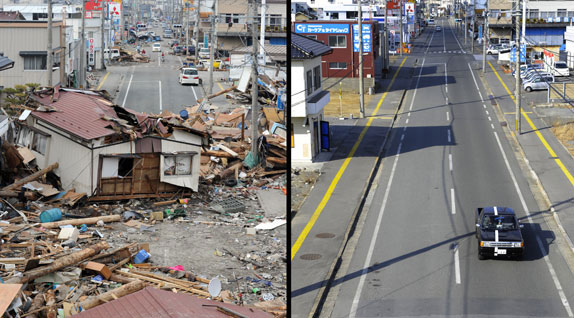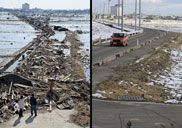 Toshifumi Kitamura/AFP/Getty Images
Toshifumi Kitamura/AFP/Getty Images
Article
Though some areas have begun to thrive again, the nation still has a long road to recovery.
Learn the why behind the headlines.
Subscribe to the Real Truth for FREE news and analysis.
Subscribe NowAlmost a year after a 9.0-magnitude earthquake and resulting tsunami rocked Japan—killing more than 19,000 people—the nation still faces colossal challenges.
 Toru Yamanaka/AFP/Getty Images
Toru Yamanaka/AFP/Getty ImagesThe temblor and massive wave, which according to the World Bank caused at least $225 billion in economic damages, has continued to take a toll, both financially and emotionally. Massive amounts of debris from more than 125,000 destroyed buildings, broken levees, continued flooding due to excessive rain, and towns without power or water services have meant a slow recovery for the nation of more than 127 million people. Many of the country’s elderly, who once lived in coastal regions, now are forced to reside in temporary housing complexes.
A snapshot of what Japan is facing reveals the state of sections of the country one year later.
- Thousands potentially still missing: “Somewhere under these unforgiving grey waters lie hundreds, perhaps thousands of bodies; the unfound, unclaimed dead of one of the country’s worst ever disasters,” Agence France-Presse stated. According to the media outlet, “One-in-six of the dead has never been found.”
- Scattered debris: Some towns are debating where to store millions of tons of rubble. And there is great concern about an island of debris in the Pacific Ocean, which will likely hit the United States in about two years. “From entire segments of wooden homes, furniture and appliances to cars and boats, the rubbish islands are creating growing concern due to environmental pollution as well as shipping hazards,” Telegraph stated. “The possibility of human bodies being included in the debris is also high, bearing in mind the thousands of victims of the disaster who are still missing, believed to have been swept out to sea.”
- Mass emigration: “More than 38,000 residents left the [tsunami-hit] area between March and August [2011], the biggest exodus since 1969,” Reuters stated. A University of Tokyo professor told the news agency, “The government has mostly focused on building seabanks, elevating land levels and other infrastructure development…But more attention is probably needed on supporting the livelihoods of people through direct assistance on employment and homes, or else people will leave.”
- Economic woes: In 2011, the cost of rice was 10 to 15 percent higher than the previous year. Commodity prices are “sinking on the risk of another global slump, while a yen trading near postwar highs has cut the cost of imports,” Bloomberg stated. The media outlet summarized a statement by the International Monetary Fund, which cautioned that “without more rapid economic growth, the nation faces the risk that its fiscal situation will deteriorate ‘precariously.’”
- Nuclear contamination: Authorities maintain that it could take 20 or more years for residents affected by the Fukushima Daiichi nuclear plant meltdown to be able to move back into the homes they fled. “[Tokyo Electric Power Co.] may have to pay 4.5 trillion yen…to compensate people who lost their homes and livelihoods because of radiation released from the Fukushima Dai-Ichi nuclear station,” Bloomberg reported in another article.
- More earthquakes: A University of Nevada geophysicist said the Tohoku earthquake was “a grim reminder of the potential for another strong-motion mega-earthquake along the Pacific Northwest coast,” according to Wharton Magazine.
But there has been some progress.
In certain areas, debris has been removed and roads repaved. A reporter from Canadian news magazine Maclean’s noted that when he last visited a hard-hit section of Japan, “the roads were strewn with muck or littered with boats, the buildings were decorated with the ropes and buoys of the oyster farms that once thrived here and the tsunami, which struck shortly after the massive earthquake of March 11, toppled buildings.
“All that’s gone now—the streets scrubbed, most of the debris carted away and sorted into metal or wood or plastic. What’s left isn’t much of a town.”
While the government hopes to clear the debris by 2014, as of late February, only five percent of rubble left by the tsunami has been cleared.
More on Related Topics:
- India Begins to Flex Naval Power as Competition with China Grows
- China’s Population Falls for a 2nd Straight Year as Births Drop Even After End of One-Child Policy
- Asia Lags Behind Pre-Pandemic Levels of Food Security, UN Food Agency Says
- China Is Building Up Its Nuclear Weapons Arsenal Faster Than Previous Projections, U.S. Report Says
- New Submarines and Nuclear Drones: Why Is North Korea Developing Its Navy?


